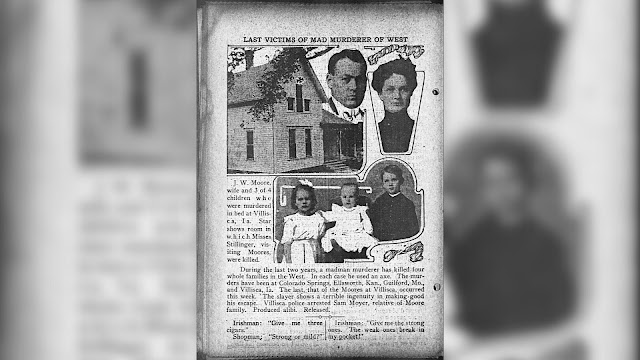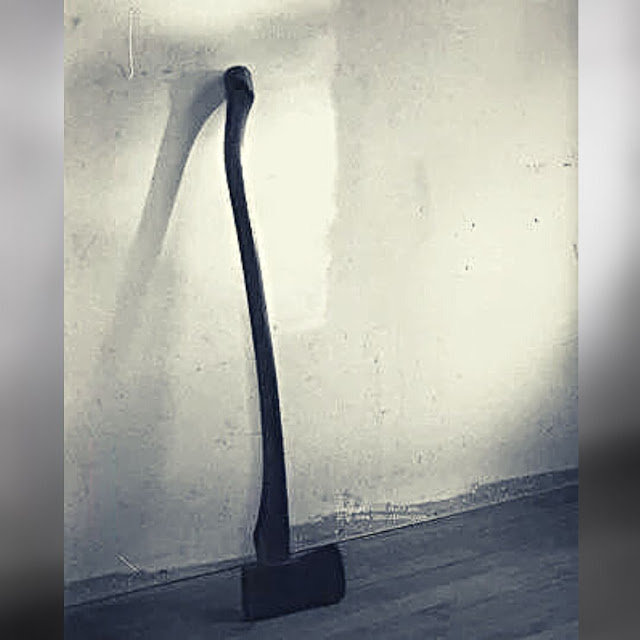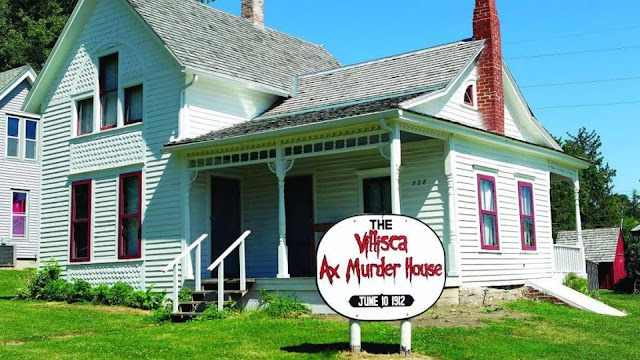Obscure Occurrences : The Villisca Axe Murders
The church service on the 9th of June, 1912 had ended at about 9:30 pm and the Moores slowly made their way back towards their home, attracting attention from the people they encountered. In synchronisation with the warm and pleasant evening, the adults maintained a slow and leisurely pace while the kids giggled and laughed as they chased each other. In addition to their four children, Josiah Moore and his wife Sarah had arranged for two of the younger daughters from the Stillinger household to spend the night at their place. The adults showed no urgency during their three-block walk from the Church, allowing the children to tire themselves in order to make their bedtime a less-intense labour.
 |
| (Source: Morbid Kuriosity) |
As the cheerful group had passed by Hank
Horton, the Town Marshal, they stopped to exchange greetings. While some of
Villisca’s other residents had demonstrated a tendency to mock the man for
diligence, Josiah admired the manner with which Horton performed his duty. They
eventually reached the Moore residence following which Sarah gently guided the
children into the kitchen for a serving of milk and cookies before settling
them down into their beds. Parallelly, Josiah made his way to the woodpile to
fetch fuel for the fireplace.
After collecting an armful of logs, Josiah nudged the axe lying on the floor with his foot, trying to push it a little further under the pile, in order to conceal it from the sight of passers-by. It was an insignificant act, one that he had repeated every evening since moving into the property, but unbeknownst to him, he was being keenly observed that evening.
After completing his task, Josiah walked back
over to the house and shut the door behind him. Candlelight and sounds of
happiness emanated from the main residence while the woodpile stood silent a few
feet away from the barn. Hidden away in the outbuilding’s darkened interior, a
man stared intently across the yard through a small hole in the wooden wall.
The happy group had caught his attention, causing his gaze to fall upon
twelve-year-old Lena, the older of the two Stillinger girls, for a short
period.
The lamps in the Moore household were slowly
extinguished one by one as the family and their two little guests settled into
their beds, filling the uninvited stranger with a warm and pleasant feeling.
Shortly afterwards, he would go on to satisfy the painful urges that had grown
to consume him.
Discovery
The following day, Mary Peckham, the family’s
elderly neighbour, noticed that nobody had emerged from the Moore residence
that morning to tend to their animals. She let the family’s chickens out for
them before proceeding to knock on their main door. The warm woman was not able
to raise anyone’s attention despite several attempts and found that all of the
building’s windows had been covered with either curtains or bedsheets. She
immediately returned home and called Ross Moore, Josiah’s brother who worked at
the nearby drug store, for assistance.
Ross arrived shortly, only to fail in his
attempts to elicit a response from inside. Using the spare key Josiah had given
him, he eventually gained entry. However, he still had to use a degree of force
to open the front door, as it had been closed from the inside with clothing on
its edges. Ross cautiously stepped into the house, immediately noticing the
deafening silence accompanied by an odd smell which hung in the air. Firstly,
he arrived at the guest bedroom, where he found the lifeless bodies of the two
Stillingier girls. The bedsheets covering them were drenched in their own blood.
Unnerved by the grotesque sight, Ross stumbled
back out of the dark house and yelled at Mary, who had been waiting outside, to
call for Hank Horton. When the town’s Peace Officer arrived half an hour later,
he found Ross sitting near the house with his head buried in his hands. The Marshal immediately ventured into the house alone and he emerged a few minutes
later with a pale face. The hardworking local official, whose duties involved
dealing with thefts and bar room brawls, was not prepared for something of this
magnitude. Recovering his composure, he immediately started to issue relevant
orders, summoning the Sheriff from nearby Red Oak along with men from the National
Guard to secure the crime scene. Canines were also requested for assistance.
 |
| (Source: Wiki Media) |
Details of the Murder
Horton headed into the town, enlisting the help
of a doctor and photographer to help him document his findings. Parallelly, the
deputies and soldiers that arrived to guard the scene were deeply affected by the
horror which had consumed Horton. Every occupant inside the house was dead, mauled
with the use of Josiah’s axe, which had been left carefully against the wall in
the guest bedroom, next to the lifeless bodies of the Stillinger children. Two
fresh cigarette buts were later found in the attic, indicating that the murderer
might have concealed himself there after entering the property, patiently
waiting till everyone fell asleep.
The first to die were Josiah and Sarah, both
battered to death in the master bedroom. Sarah’s skull had been broken with the
blunt end of the axe while her husband’s head had been slaughtered with the
bladed end. From there, the murdered had paraded through the other family bedrooms,
killing Herman, Mary, Arthur and five-year-old Paul by thumping their heads with
the axe’s blunt end. After the onslaught, it appeared that the man had returned
to the parents’ bedroom, attacking Josiah’s face with the blunt side of the weapon.
The blows had been so strong that his eyes had liquified under the pressure.
The murder had then diverted his attention towards
the Stillinger girls, who had been sleeping in the guest bedroom. The positioning
of Lena’s corpse suggested that she had been the only victim to have woken up
during the bloody massacre. She lay slightly further down than her younger
sister as if trying to wiggle free from her attacker. The wound on her upper
arm suggested that she had held it outstretched in an effort to shield herself
from the murderer’s blows of death.
Lena’s night clothes were pulled up and her
underwear had been used by the killer to wipe the blood from the murder weapon.
Unfortunately, this was not the last of the grisly and unnerving details. One
of Sarah’s shoes, which had been placed underneath her bed, had filled up with
her blood. The attacker had knocked it over when he had re-entered to inflict
further damage to her husband’s corpse.
The crime scene suggested that the killer had
been deliberate and methodical, taking his time as he went about bludgeoning
the family to death. He had used all the bedding and clothes in the house to
hide the faces of his victims, to cover up the windows and the mirrors and to
wedge the external doors closed. He had also moved a slab of bacon from the
ice box to the guest bedroom, poured a bowl of water to wash his hands and then
left it on the table along with the remainders of a small meal he had
apparently prepared.
In line with Doctor Cooper’s report, each
victim had been killed by repeated blows from the axe, around twenty to thirty strikes
each in some cases. The indentations on the ceilings of each bedroom suggested
that the killer had swung the axe down from a commendable height, grazing the
roof beams as it passed.
 |
| (Source: Morbid Kuriosity) |
Investigation
Word of the murders had quickly spread beyond
the town’s borders, causing the gathering of a substantial crowd from all over
the country when the bodies were recovered. As darkness fell and the tracker
dogs finally arrived, the residents retreated to their homes and locked their
doors. The once-calm streets of Villisca were no longer a safe place to be at
night.
As the sheriff and his deputies used the
canine units to track the killer’s route away from the house, Horton had
trailed behind due to his involvement in the investigation. The dogs paused briefly
at the door of Frank Jones, a prominent businessman, before suddenly moving off
again. They lost the trial at the nearby Nodaway River, unable to identify the
direction in which the murderer had taken after crossing the water. Enquiries
at local hotels failed to propose a potential suspect, and neither was the
stationmaster able to recall seeing any suspicious passengers arriving or
departing the town. Thus, by the end of the first 48 hours, the investigating authorities
had no further clues to pursue.
With no state police or FBI in existence back
then, a fund was organized in order to pay for a private investigation into the
murders. There were four major investigative agencies operating in the United
States at the time of the incident and the Kansas office of the Burns Detective
Agency was given the responsibility. Through a combination of undercover work
and public appeals, the agents who were dispatched to the town identified a number
of suspects and arrested them.
Josiah Moore had been a revered member of the
community with no known enemies, but he had never had a good relationship with
Sam Moyer, his brother-in-law. Witnesses confirmed that during a family argument,
Sam had once threatened to kill Josiah. Sam was arrested and interviewed, but the
evidence against him was non-existent. Thus, as soon as he produced an alibi, he
was released.
Andrew Sawyer, a local itinerant, was detained next. The day after the murders he had approached a nearby railway crew, asking if any work was available. His clothes, however, were sodden and dirty. His foreman had contacted the sheriff to report that Andrew kept on making repeated references to having just come from Villisca and knowing more about the case than he was supposed to. The deputies who arrested Andrew reported that he had immediately become enraged, threatening to behead them. However, it was later proven that he had been in police custody on the night of the murders.
Henry Moore, a convicted killer who had
murdered his mother and grandmother with an axe, was later interviewed by the
police but there was insufficient evidence to associate him with the crime.
James Newton
In an effort to resume the investigation that
had stalled after two years, the Bruns Agency despatched another agent to Villisca.
The newly assigned detective’s motive, however, was less about seeking justice
and more about seeking wealth. The name of the deceitful and greedy agent was James
Newton and he had built a moderately successful career by manufacturing and
twisting the affairs of each case to fit his desired outcome. In the Villisca
investigation, his technique would be taken to a further level.
Immediately after arriving in the town, James seized
on the fact that the canines had paused momentarily at Frank Jones' doorstep and
set about putting together a case against him. Jones owned a tool company that
Josiah had once managed for him. When he had left his position to start his own
business, a notable portion of Jones’ customers followed him. Using this tale
as the motive for the murders, James initiated a public campaign to get Jones associated
with the crime. As Jones had successfully campaigned to be elected as a Senator,
he sought out his rivals for funding.
James held public meetings, taking the word of
any lunatic as solid fact until he constructed a sufficient narrative to put
before a curt gathering. However, not one of the witnesses he bought into the
courtroom had credibility, causing his first attempt to convict James to fail.
In July of 1914, two years after the massacre in Moore’s residence, William Mansfield, an Illinois resident and army veteran,
was arrested on suspicion of using an axe to kill four members of his own
family. The new arraignment that James bought into the court maintained that Jones
had paid him to murder the Moore family. Jones persistently fought the
allegation until he and William were cleared of the charges six years later.
Eventually, James’ career ended in disgrace.
It was discovered that he had been using the funds of the case to fund his political
career, causing his removal from the case, but the damage he had already caused
to the wider investigation of the murders was irreparable. He was sacked altogether several years later, after being caught having an affair with the wife of a
client.
A Self-Proclaimed Killer
The last suspect to be charged with the
killings was George Kelly, the minister who had spoken at the service the Moores
had attended on the right of their deaths. He had attempted to accuse himself in the early days of Hank Horton’s investigation but had been warned off due
to his mental health issues.
In 1914, Kelly was committed to a mental
facility, after trying to persuade a 16-year-old girl to sleep with him. While
being held there, he allegedly confessed to the Villisca Axe Murders again. He was
tried at court twice for the crimes and released on both occasions when it was
proven that his account had no resemblance to the case itself.
Conclusion
The savage and brutal nature of the crime committed
at the heart of the community alarmed the local residents. With modern technologies to aid, it is comparatively easier to analyse and evaluate
such incidents, but to the people of that era, it was nothing but incomprehensible. The Moore residence still sits in Villisca, serving as a reminder of the brutal bludgeoning of its owners while protecting the identity of their killer.
 |
| (Source: Morbid Kuriostiy) |
The circumstances surrounding the murders seemingly suggested that the killer must have had an existing link to the victims and the town, causing a closed line of thinking which was not sufficient enough to catch the killer. Furthermore, James muddying the waters made the situation worse. Unfortunately, despite the advancements in technology and forensic science, the case remains a century-old mystery.
Post a Comment